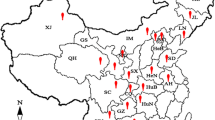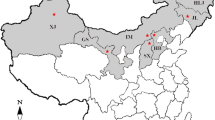Abstract
From 2012 to 2015, a total of 226 isolates of Rhizoctonia solani were collected from the stem cankers on potato stems and sclerotia on tubers from different potato cultivation areas of Heilongjiang Province, China. These isolates were assigned to the anastomosis group (AG) by performing conventional PCR assays using previously published primers for ITS-rDNA regions, as well as by observing hyphal interactions where appropriate. Most of the isolates were assigned to AG-3PT (58.85 %), and several were assigned to AG-5 (21.68 %), AG-2-1 (7.08 %) and AG-4 (12.39 %). Pathogenicity tests showed that the AG-3 and AG-5 isolates had the highest virulence, and the disease indices were 1.96a and 2.47a for stem and 1.48a and 1.6a for root (P < 0.05) after analyzed by LSD multiple comparisons, respectively. Both two isolates consistently caused large brown lesions with sunken on the potato stems and roots in in vitro and greenhouse experiments. This is the first detailed report on the AG composition, variability and pathogenicity of R. solani isolates associated with stem cankers and black scurf found on potatoes cultivated in Heilongjiang Province.
Resumen
Del 2012 al 2015, se colectó un total de 226 aislamientos de Rhizoctonia solani de las lesiones del tallo y esclerocios de los tubérculos de diferentes áreas de cultivo de papa de la provincia de Heilongjiang, China. Estos aislamientos se asignaron al grupo de anastomosis (AG) mediante la conducción de ensayos convencionales de PCR utilizando iniciadores previamente publicados de las regiones ITS-rDNA, así como mediante la observación de las interacciones de las hifas cuando fue apropiado. La mayoría de los aislamientos fueron asignados a AG-3PT (58.85 %) y varios a AG-5 (21.68 %), AG-2-1 (7.08 %) y AG-4 (12.39 %). Las pruebas de patogenicidad mostraron que los aislamientos AG-3 y AG-5 tenían la virulencia más alta, y los índices de la enfermedad fueron 1.96a y 2.47a para tallo y de1.48a y 1.6a para raíz (P < 0.05) después de ser analizados mediante comparaciones múltiples LSD respectivamente. Ambos tipos de aislamientos causaron consistentemente grandes lesiones cafés con hundimientos en los tallos y raíces de papa en experimentos in vitro y de invernadero. Este es el primer reporte detallado en la composición de AG, variabilidad y patogénesis de aislamientos de R. solani asociados con cáncer del tallo y la costra negra encontrados en papa cultivada en la Provincia de Heilongjiang.



Similar content being viewed by others
References
Anguiz, R., and C. Martin. 1989. Anastomosis groups, pathogenicity, and other characteristics of rhizoctonia solani isolated from potatoes in Peru. Plant Disease 73: 199–201. doi:10.1094/PD-73-0199.
Bains, P.S., and V. Bisht. 1995. Anastomosis group identity and virulence of rhizoctonia solani isolates collected from potato plants in Alberta, Canada. Plant Disease 79: 241–242. doi:10.1094/PD-79-0241.
Balali, G.R., S.M. Neate, E.S. Scott, D.L. Whisson, and T.J. Wicks. 1995. Anastomosis group and pathogenicity of isolates of rhizoctonia solani from potato crops in South Australia. Plant Pathology 44: 1050–1057. doi:10.1111/j.1365-3059.1995.tb02664.x.
Bandy, B.P., S. Leach, and S. Tavantzis. 1988. Anastomosis Group 3 is the Major cause of rhizoctonia disease of potato in Maine. Plant Disease 72: 596–598. doi:10.1094/PD-72-0596.
Banville, G. 1989. Yield losses and damage to potato plants caused by rhizoctonia solani Kuhn. American Potato Journal 66: 821–834.
Campion, C., C. Chatot, B. Perraton, and D. Andrivon. 2003. Anastomosis groups, pathogenicity and sensitivity to fungicides of rhizoctonia solani isolates collected on potato crops in France. European Journal of Plant Pathology 109: 983–992. doi:10.1023/B:EJPP.0000003829.83671.8f.
Carling, D. 1996. Grouping in rhizoctonia solani by hyphal anastomosis interactions. In Rhizoctonia species: taxonomy, molecular biology, ecology, pathology, and disease control, eds. B. Senh, S. Jabaji-Hare, S. Neate, and G. Dijst, 37–47. Dordrecht: Kluwer Academic Publishers.
Carling, D.E., and R. Leiner. 1986. Isolation and characterization of rhizoctonia solani and binucleate R. solani-like fungi from aerial stems and subterranean organs of potato plants. Phytopathology 76: 725–729. doi:10.1094/Phyto-76-725.
Carling, D.E., and R. Leiner. 1990a. Effect of temperature on virulence of rhizoctonia solani and other rhizoctonia on potato. Phytopathology 80: 930–934. doi:10.1094/Phyto-80-930.
Carling, D.E., and R. Leiner. 1990b. Virulence of isolates of rhizoctonia solani AG-3 collected from potato plant organs and soil. Plant Disease 74: 901–903. doi:10.1094/PD-74-0901.
Carling, D.E., R. Leiner, and K. Kebler. 1987. Characterization of a new anastomosis group (AG-9) of rhizoctonia solani. Phytopathology 77: 1609–1612. doi:10.1094/Phyto-77-1609.
Carling, D.E., S. Kuninaga, and And K.A. Brainard. 2002. Hyphal anastomosis reactions, rDNA-internal transcribed spacer sequences, and virulence levels among subsets of rhizoctonia solani anastomosis group-2 (AG-2) And AG-BI. Phytopathology 92: 43–50. doi:10.1094/PHYTO.2002.92.1.43.
Chand, T., and C. Logan. 1983. Cultural and pathogenic variation in potato isolates of rhizoctonia solani in Northern Ireland. Transactions of the British Mycological Society 81: 585–589. doi:10.1016/S0007-1536(83)80129-6.
Cubeta, M.A., and R. Vilgalys. 1997. Population biology of the rhizoctonia solani complex. Phytopathology 87: 480–484. doi:10.1094/PHYTO.1997.87.4.480.
Das, S., F.A. Shah, R.C. Butler, R.E. Falloon, A. Stewart, S. Raikar, and A.R. Pitman. 2014. Genetic variability and pathogenicity of rhizoctonia solani associated with black scurf of potato in New Zealand. Plant Pathology 63: 651–666. doi:10.1111/ppa.12139.
Fiers, M., V. Edel-Hermann, C. Héraud, N. Gautheron, C. Chatot, Y. Le Hingrat, K. Bouchek-Mechiche, and C. Steinberg. 2011. Genetic diversity of rhizoctonia solani associated with potato tubers in France. Mycologia 103: 1230–1244. doi:10.3852/10-231.
González, D., M.A. Cubeta, and R. Vilgalys. 2006. Phylogenetic utility of indels within ribosomal DNA and beta-tubulin sequences from fungi in the rhizoctonia solani species complex. Molecular Phylogenetics and Evolution 40: 459–470. doi:10.1016/j.ympev.2006.03.022.
Hide, G.A., and J.P. Firmager. 1990. Effects of an isolate of rhizoctonia solani Kuhn AG8 from diseased barley on the growth and infection of potatoes (Solanum tuberosum L.). Potato Research 33: 229–234. doi:10.1007/BF02358450.
Johnk, J.S., R. Jones, H. Shew, and D. Carling. 1993. Characterization of populations of rhizoctonia solani AG-3 from potato and tobacco. Phytopathology 83: 854–858. doi:10.1094/Phyto-83-854.
Kuninaga, S., T. Natsuaki, T. Takeuchi, and R. Yokosawa. 1997. Sequence variation of the rDNA its regions within and between anastomosis groups in rhizoctonia solani. Current Genetics 32: 237–243. doi:10.1007/s002940050272.
Kuninaga, S., D.E. Carling, T. Takeuchi, and R. Yokosawa. 2000. Comparison of rDNA-ITS sequences between potato and tobacco strains in rhizoctonia solani AG-3. Journal of General Plant Pathology 66: 2–11. doi:10.1007/PL00012917.
Lees, A.K., D.W. Cullen, L. Sullivan, and M.J. Nicolson. 2002. Development of conventional and quantitative real-time PCR assays for the detection and identification of rhizoctonia solani AG-3 in potato and soil. Plant Pathology 51: 293–302. doi:10.1046/j.1365-3059.2002.00712.x.
Lehtonen, M., P. Ahvenniemi, P. Wilson, M. German-Kinnari, and J. Valkonen. 2008. Biological diversity of rhizoctonia solani (AG3) in a northern potato-cultivation environment in Finland. Plant Pathology 57: 141–151.
Li, X., N. Xu, and J. Yu. 2014. Anastomosis groups of rhizoctonia solani from black scurf of potato in northern China. Mycosystema 33: 584–593.
MacNish, G.C., D.E. Carling, and K.A. Brainard. 1997. Relationship of microscopic and macroscopic vegetative reactions in rhizoctonia solani and the occurrence of vegetatively compatible populations (VCPs) in AG-8. Mycological Research 101: 61–68. doi:10.1017/S0953756296002171.
Misawa, T., and S. Kuninaga. 2010. The first report of tomato foot rot caused by rhizoctonia solani AG-3 PT and AG-2-Nt and its host range and molecular characterization. Journal of General Plant Pathology 76: 310–319. doi:10.1007/s10327-010-0261-2.
Neate, S.M., R.H. Cruickshank, and A.D. Rovira. 1988. Pectic enzyme patterns of rhizoctonia solani isolates from agricultural soils in South Australia. Transactions of the British Mycological Society 90: 37–42. doi:10.1016/S0007-1536(88)80177-3.
Ogoshi, A. 1987. Ecology and pathogenicity of anastomosis and intraspecific groups of rhizoctonia Solani Kuhn. Annual Review of Phytopathology 25: 125–143. doi:10.1146/annurev.py.25.090187.001013.
Ogoshi, A. 1996. The genus rhizoctonia. In Rhizoctonia species: taxonomy, molecular biology, ecology, pathology and disease control, eds. B. Sneh, S. Jabaji-Hare, S. Neate, and G. Dijst, 1–9. Dordrecht: Kluwer Academic Publishers.
Reynolds, M., A.R. Weinhold, and T.J. Morris. 1983. Comparison of anastomosis groups of Rhizoctonia solani by polyacrylamide gel electrophoresis of soluble proteins. Phytopathology 73: 903–906.
Rosa, L., M. Johan, C. Paulo, and G. Celsa. 2012. Rhizoctonia solani AG-3PT is the major pathogen associated with potato stem canker and black scurf in Colombia. Agronomía Colombiana 30: 204–213.
Schneider, J.H.M., M.T. Schilder, and G. Dijst. 1997. Characterisation of rhizoctonia solani AG2 isolates causing bare patch in held grown tulips in the Netherlands. European Journal of Plant Pathology 103: 265–279. doi:10.1023/A:1008643311984.
Sharon, M., B. Sneh, S. Kuninaga, and M. Hyakumachi. 2006. The advancing identification and classification of rhizoctonia spp. Using molecular and biotechnological methods compared with the classical anastomosis grouping. Mycoscience 47: 299–316. doi:10.1007/S10267-006-0320-X.
Sharon, M., B. Sneh, S. Kuninaga, M. Hyakumachi, and S. Naito. 2008. Classification of rhizoctonia spp. Using rDNA-its sequence analysis supports the genetic basis of the classical anastomosis grouping. Mycoscience 49: 93–114. doi:10.1007/S10267-007-0394-0.
Sweetingham, M.W., R.H. Cruickshank, and D.H. Wong. 1986. Pectic zymograms and taxonomy and pathogenicity of the Ceratobasidiaceae. Transactions of the British Mycological Society 86: 305–311. doi:10.1016/S0007-1536(86)80161-9.
Tian, X., M. Meng, X. Zhang, R. Dong, and J. Hu. 2011. Identification of anastomosis groups of rhizoctonia solani on potato plant. Chinese Potato Journal 25: 298–301.
White, T., T. Bruns, S. Lee, and J. Taylor. 1990. Amplification and direct sequencing of fungal ribosomal RNA genes for phylogenetics. In PCR protocols: A guide to methods and applications, eds. M. Innis, D. Gelfand, J. Shinsky, and T. White, 315–322. New York: Academic Press.
Woodhall, J.W., A.K. Lees, S.G. Edwards, and P. Jenkinson. 2007. Characterization of rhizoctonia solani from potato in Great Britain. Plant Pathology 56: 286–295. doi:10.1111/j.1365-3059.2006.01545.x.
Yang, Y., C. Zhao, Z. Guo, and X. Wu. 2015. Anastomosis group and pathogenicity of rhizoctonia solani associated with stem canker and black scurf of potato in China. European Journal of Plant Pathology 143: 99–111. doi:10.1007/s10658-015-0668-x.
Zhang, C., Z. Yang, Y. Wang, and J. Zhu. 2014. Identification and analysis of anastomosis groups of rhizoctonia solani from potatoes in Inner Mongolia. Acta Phytophylacica Sinica 41: 410–414. doi:10.13802/j.cnki.zwbhxb.2014.04.009.
Acknowledgments
We gratefully acknowledge Mr. Vinh Hong Le (Norwegian Institute of Bioeconomy Research, Oslo, Norway) for his constructive reviews of the manuscript. This work was supported by the Sino-Norway Cooperative Research on Monitoring and Control of Potato Soil-borne pests (2013DFA31970) and the National Science and Technology Support Project (2012BAD06B02).
Author information
Authors and Affiliations
Corresponding author
Electronic supplementary material
ESM 1
(XLSX 22 kb)
Rights and permissions
About this article
Cite this article
Yang, S., Min, F., Wang, W. et al. Anastomosis Group and Pathogenicity of Rhizoctonia solani Associated with Stem Canker and Black Scurf of Potato in Heilongjiang Province of China. Am. J. Potato Res. 94, 95–104 (2017). https://doi.org/10.1007/s12230-016-9535-3
Published:
Issue Date:
DOI: https://doi.org/10.1007/s12230-016-9535-3




